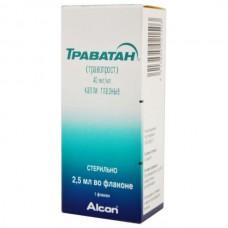Expiration date: 04/2026
The composition and form of issue:
Eye drops, 1 ml contains:
travoprost 0.04 mg
excipients: macrogol glycerylmonostearate (synonym polyoxyethylene hydrogenated castor oil 40 — NSO-40) benzalkonium chloride solution (equivalent to benzalkonium chloride) disodium edetate boric acid trometamol mannitol sodium hydroxide and/or hydrochloric acid concentrated — to bring the pH of purified water
in vials-droppers-plastic 2.5 ml (with a dosing device "Drop Tainer™") in aluminum foil bags of 1 or 3 bottles in the stack cartons 1 package.
Description pharmaceutical form:
Transparent or opalescent solution from colorless to slightly yellow.
Pharmacokinetics:
Travoprost absorbed through the cornea where travoprost hydrolysis to the biologically active form — acid travoprost. Travoprost Cmax in plasma is reached within 30 min after local application and is 25 PG/ml or less.
Travoprost is rapidly eliminated from plasma within an hour the concentration decreases below detection limits (<10 PG/ml).
Travoprost is excreted as inactive metabolites mainly in the bile (61%), the rest is excreted by the kidneys.
Description pharmacological action:
Travoprost — synthetic analogue PGF2a is highly selective agonist of prostaglandin receptor PR and reduces intraocular pressure by increasing outflow of aqueous humor. The primary mechanism of action of the drug is associated with an increase in uveoscleral outflow.
Intraocular pressure is reduced approximately 2 h after application, and the maximum effect is achieved after 12 h
Indications:
Reduction of elevated intraocular pressure in the following conditions:
- open-angle glaucoma
- elevated IOP.
Contraindications:
- individual hypersensitivity to product components
- children up to age 18 years.
Precautions: risk factors for development of macular edema (aphakia, pseudophakia, damage to the posterior capsule of the lens), acute iritis, uveitis.
Application of pregnancy and breast-feeding:
Travatan is contraindicated for women during pregnancy. Sufficient experience in use of the drug during lactation is not. Perhaps the use Travatan for the treatment of nursing mothers on the prescription of the medical doctor, if the expected therapeutic effect exceeds the risk of possible side effects for the baby.
Side effects:
In 35% of cases observed transient slightly pronounced hyperemia of the conjunctiva, passing without additional therapy over time.
In 5-10% of cases — decreased visual acuity, discomfort and "feeling of foreign body", pain, itching, burning sensation in the eyes.
In 1-4% of cases, visual disturbances, blepharitis, "fog" before the eyes, cataract, conjunctivitis, dryness of the conjunctiva, discoloration of the iris, keratitis, formation of crusts on the eyelids, photophobia, subconjunctival hemorrhage, and increased lacrimation.
Systemic side effects are observed in 1-5% of cases: General anxiety, headache, depression, increase or decrease in blood pressure, bradycardia, angina, chest pain, arthritis, back pain, flu-like symptoms, sinusitis, bronchitis, hypercholesterolemia, dyspepsia, urinary incontinence and urinary tract infections.
Drug interactions:
Travatan can be used in combination with other topical ophthalmic drugs to lower intraocular pressure. In this case, the interval between their use needs to be at least 5 min.
Method of application and dose:
Into the conjunctival SAC. 1 drop 1 time a day, in the evening. More frequent use of the drug can diminish its effectiveness.
Overdose:
Symptoms: irritation of eyes, redness of the conjunctiva or episclera.
Treatment: symptomatic.
Special instructions:
Travatan may cause a gradual change in eye color by increasing the amount brown pigment in the iris. This effect is revealed mainly in patients with mixed colour irides, such as blue-brown, gray-brown, green-brown or yellow - brown, which is due to increased melanin content in stromal melanocytes of the iris. Usually brown pigmentation extends concentrically around the pupil to the periphery of the iris of the eye, the entire iris or parts of it could become more intense brown color. In patients with a uniformly colored eyes of blue, gray, green or brown color change eyes after two years of use of the drug was observed very rarely. The color change is not accompanied by any clinical symptoms or pathological changes. After the drug was observed a further increase in the number of brown pigment, but has developed the color change may be irreversible. In the presence of nevi or lentigines on the iris is not noted their changes under the influence of therapy Travatan. The drug can cause darkening, thickening and lengthening of the eyelashes and/or increase their number rarely darkening of the eyelid skin.
Before starting treatment patients should be informed about the possibility of changing eye color. Treatment only one eye may result in permanent heterochromia.
Travatan contains a preservative benzalkonium chloride which can be absorbed by contact lenses. Before the instillation of the drug lenses should be removed. Set back no earlier than 20 minutes after instillation of the drug.
The bottle must be closed after each use. Do not touch the tip of the pipette to the eye.
MANUFACTURER
C. and. Alcon-Couvreur N. V., B-2870 Puurs, Belgium.


